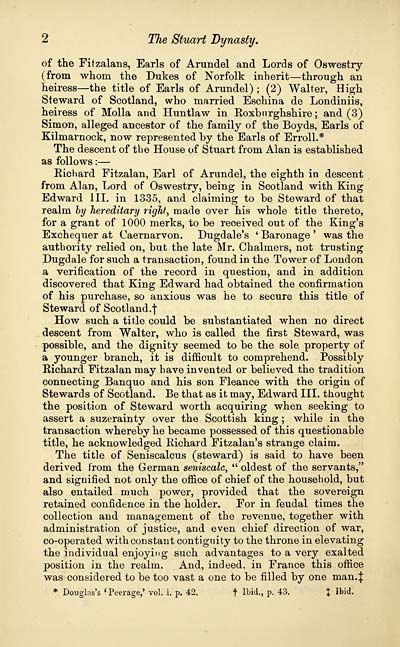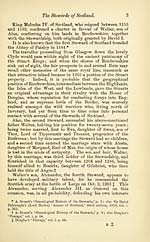Stuart dynasty
(22) Page 2
Download files
Complete book:
Individual page:
Thumbnail gallery: Grid view | List view

2 The Stuart Dynasty.
of the Fitzalans, Earls of Arundel and Lords of Oswestry
(from whom the Dukes of Norfolk inherit — through an
heiress — the title of Earls of Arundel) ; (2) Walter, High
Steward of Scotland, who married Eschina de Londiniis,
heiress of Molla and Huntlaw in Roxburghshire ; and (3)
Simon, alleged ancestor of the family of the Boyds, Earls of
Kilmarnock, now represented by the Earls of ErrolL*
The descent of the House of Stuart from Alan is established
as follows : —
Richard Fitzalan, Earl of Arundel, the eighth in descent
from Alan, Lord of Oswestry, being in Scotland with King
Edward III. in 1335, and claiming to be Steward of that
realm by hereditary right, made over his whole title thereto,
for a grant of 1000 merks, to be received out of the King's
Exchequer at Caernarvon. Dugdale's ' Baronage ' was the
authority relied on, but the late Mr. Chalmers, not trusting
Dugdale for such a transaction, found in the Tower of London
a verification of the record in question, and in addition
discovered that King Edward had obtained the confirmation
of his purchase, so anxious was he to secure this title of
Steward of Scotland.f
How such a title could be substantiated when no direct
descent from Walter, who is called the first Steward, was
possible, and the dignity seemed to be the sole property of
a younger branch, it is difficult to comprehend. Possibly
Richard Fitzalan may have invented or believed the tradition
connecting Banquo and his son Fleance with the origin of
Stewards of Scotland. Be that as it may, Edward III. thought
the position of Steward worth acquiring when seeking to
assert a suzerainty over the Scottish king ; while in the
transaction whereby he became possessed of this questionable
title, he acknowledged Richard Fitzalan's strange claim.
The title of Seniscalcus (steward) is said to have been
derived from the German seniscala, " oldest of the servants,"
and signified not only the office of chief of the household, but
also entailed much power, provided that the sovereign
retained confidence in the holder. For in feudal times the
collection and management of the revenue, together with
administration of justice, and even chief direction of war,
co-operated with constant contiguity to the throne in elevating
the individual enjoying such advantages to a very exalted
position in the realm. And, indeed, in France this office
was considered to be too vast a one to be filled by one man. J
* Douglas's ' Peerage,' vol. i. p. 42. f Ibid., p. 43. J Ibid.
of the Fitzalans, Earls of Arundel and Lords of Oswestry
(from whom the Dukes of Norfolk inherit — through an
heiress — the title of Earls of Arundel) ; (2) Walter, High
Steward of Scotland, who married Eschina de Londiniis,
heiress of Molla and Huntlaw in Roxburghshire ; and (3)
Simon, alleged ancestor of the family of the Boyds, Earls of
Kilmarnock, now represented by the Earls of ErrolL*
The descent of the House of Stuart from Alan is established
as follows : —
Richard Fitzalan, Earl of Arundel, the eighth in descent
from Alan, Lord of Oswestry, being in Scotland with King
Edward III. in 1335, and claiming to be Steward of that
realm by hereditary right, made over his whole title thereto,
for a grant of 1000 merks, to be received out of the King's
Exchequer at Caernarvon. Dugdale's ' Baronage ' was the
authority relied on, but the late Mr. Chalmers, not trusting
Dugdale for such a transaction, found in the Tower of London
a verification of the record in question, and in addition
discovered that King Edward had obtained the confirmation
of his purchase, so anxious was he to secure this title of
Steward of Scotland.f
How such a title could be substantiated when no direct
descent from Walter, who is called the first Steward, was
possible, and the dignity seemed to be the sole property of
a younger branch, it is difficult to comprehend. Possibly
Richard Fitzalan may have invented or believed the tradition
connecting Banquo and his son Fleance with the origin of
Stewards of Scotland. Be that as it may, Edward III. thought
the position of Steward worth acquiring when seeking to
assert a suzerainty over the Scottish king ; while in the
transaction whereby he became possessed of this questionable
title, he acknowledged Richard Fitzalan's strange claim.
The title of Seniscalcus (steward) is said to have been
derived from the German seniscala, " oldest of the servants,"
and signified not only the office of chief of the household, but
also entailed much power, provided that the sovereign
retained confidence in the holder. For in feudal times the
collection and management of the revenue, together with
administration of justice, and even chief direction of war,
co-operated with constant contiguity to the throne in elevating
the individual enjoying such advantages to a very exalted
position in the realm. And, indeed, in France this office
was considered to be too vast a one to be filled by one man. J
* Douglas's ' Peerage,' vol. i. p. 42. f Ibid., p. 43. J Ibid.
Set display mode to:
![]() Universal Viewer |
Universal Viewer | ![]() Mirador |
Large image | Transcription
Mirador |
Large image | Transcription
Images and transcriptions on this page, including medium image downloads, may be used under the Creative Commons Attribution 4.0 International Licence unless otherwise stated. ![]()
| Histories of Scottish families > Stuart dynasty > (22) Page 2 |
|---|
| Permanent URL | https://digital.nls.uk/94818030 |
|---|
| Description | A selection of almost 400 printed items relating to the history of Scottish families, mostly dating from the 19th and early 20th centuries. Includes memoirs, genealogies and clan histories, with a few produced by emigrant families. The earliest family history goes back to AD 916. |
|---|
![[Page 1]Stewards of Scotland, 1124-1370](https://deriv.nls.uk/dcn4/9481/94818020.4.jpg)
